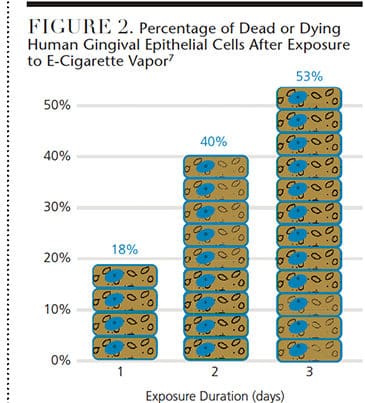Trends in Treating Smoking-Related Oral Health Issues
In a good news/bad news scenario, a U.S. Centers for Disease Control and Prevention (CDC) report finds the proportion of U.S. adults who smoke cigarettes declined from 20.9% in 2005 to 15.1% in 2015.
In a good news/bad news scenario, a U.S. Centers for Disease Control and Prevention (CDC) report finds the proportion of U.S. adults who smoke cigarettes declined from 20.9% in 2005 to 15.1% in 2015.1 Dentists have long treated the oral health issues associated with smoking, from periodontal disease and discolored teeth to chronic oral malodor. In addition, dental providers have become the key screeners for oral cancer. Unfortunately, even as traditional smoking is declining, the use of e-cigarettes is increasing. One study of data from 2012 and 2013 found that sales grew 320% for disposable e-cigarettes, 72% for starter kits, and 82% for cartridges.2 The global market research firm BIS estimates that the U.S. e-cigarette and vaporizer market will be worth $20.2 billion by 2025.3
 Rather than smoking disappearing, the use of e-cigarettes and vaporizers appears to be replacing combustible cigarettes, especially among young users. The CDC finds that while high school students are smoking less than ever before, they are using e-cigarettes at more than twice the rate of regular cigarettes (Figure 1).4
Rather than smoking disappearing, the use of e-cigarettes and vaporizers appears to be replacing combustible cigarettes, especially among young users. The CDC finds that while high school students are smoking less than ever before, they are using e-cigarettes at more than twice the rate of regular cigarettes (Figure 1).4
Will these new e-cigarette users be less prone to oral health problems than traditional cigarette users? E-cigarette companies say yes,5 but researchers say more information is needed. Last year, the National Institute of Dental and Craniofacial Research solicited funding applications for studies that would look at how aerosol mixtures produced by e-cigarettes may impact oral health. Some studies have already been completed, and the news is not good. In August, researchers at the University of Rochester and Stony Brook University, both in New York, published findings that e-cigarette vapor caused gingival tissue cell damage similar to that caused by tobacco smoke, and that flavorings added to the vapor exacerbate the damage.6 Similarly, Canadian researchers found that exposing epithelial cells to e-cigarette vapor triggered an apoptotic response (Figure 2).7
Although the e-cigarette market is starting to face regulatory pressure, it seems likely that dentists will continue to treat “smoking” related oral health problems for some time to come. Dental teams can do their part to curb the increase in e-cigarette use — especially among younger and more impressionable patients — by offering patient education, and by having smoking cessation resources lined up and ready to share via office handouts, texts or email. It’s time to snub out e-cigarette use.
REFERENCES
- Jamal A, King BA, Neff LJ, Whitmill J, Babb SD, Graffunder CM. Current cigarette smoking among adults — United States, 2005–2015. MMWR Morb Mortal Wkly Rep. 2016;65:1205–1211.
- Loomis BR, Rogers T, King BA, et al. National and state-specific sales and prices for electronic cigarettes — U.S., 2012–2013. Am J Prev Med. 2016;50:18–29.
- BIS Research. U.S. E Cigarette and Vaporizer Market. Available at: bisresearch.com/industry-report/us-electronic-cigarette-and-vaporizer-market-size-forecast-266.html. Accessed December 19, 2016.
- U.S. Centers for Disease Control and Prevention. Tobacco Use and United States Students. Available at: cdc.gov/healthyyouth/data/yrbs/pdf/2015/2015_us_tobacco.pdf. Accessed December 19, 2016.
- Ever Smoke. Protecting Your Smile — E-Cigs From a Dental Perspective. Available at: learn.eversmoke.com/protecting-your-smile.html. Accessed December 19, 2016.
- Sundar IK, Javed F, Romanos GE, Rahman I. E-cigarettes and flavorings induce inflammatory and pro-senescence responses in oral epithelial cells and periodontal fibroblasts. Oncotarget. 2016;7:77196–77204.
- Rouabhia M, Park HJ, Semlali A, Zakrzewski A, Chmielewski W, Chakir J. E-cigarette vapor induces an apoptotic response in human gingival epithelial cells through the caspase-3 pathway. Nov 3, 2016. Epub ahead of print.
- U.S. Centers for Disease Control and Prevention. Youth Risk Behavior Surveillance — United States, 2015. Available at: cdc.gov/healthyyouth/data/yrbs/pdf/2015/ss6506_updated.pdf. Accessed December 19, 2016.
From Decisions in Dentistry. January 2017;3(1):60.



